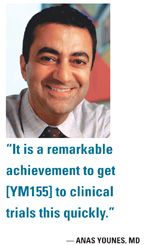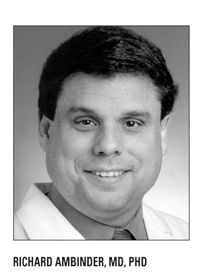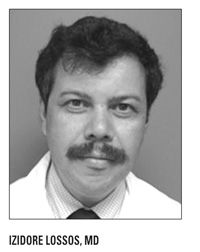New agents for lymphoma take center stage
From naked antibodies to arsenic-laced molecules to anti-survivin antibodies, three up-and-coming agents are potential standouts in the lymphoma treatment arsenal. SGN-35 is an immunoconjugate that could offer a novel approach to Hodgkin’s lymphoma therapy. Then there are darinaparsin, an organic arsenic molecule, and YM155, which may be able to restore normal apoptotic activity in advanced and aggressive lymphoma, respectively. Researchers working with these drugs discuss their studies and trials while hematologic experts offer some perspective on the future of these agents.
From naked antibodies to arsenic-laced molecules to anti-survivin antibodies, three up-and-coming agents are potential standouts in the lymphoma treatment arsenal. SGN-35 is an immunoconjugate that could offer a novel approach to Hodgkin’s lymphoma therapy. Then there are darinaparsin, an organic arsenic molecule, and YM155, which may be able to restore normal apoptotic activity in advanced and aggressive lymphoma, respectively. Researchers working with these drugs discuss their studies and trials while hematologic experts offer some perspective on the future of these agents.

SGN-35
SGN-35 is an antibody-drug conjugate targeting CD30. In a phase I dose-escalating study, SGN-35 was well tolerated at weekly dosing in patients with relapsed or refractory Hodgkin’s lymphoma or systemic anaplastic large-cell lymphoma (sALCL), reported Nancy L. Bartlett, MD, professor in the medical oncology section at Washington University in St. Louis. Dr. Bartlett presented these study results at ASCO 2009 in Orlando. Of 27 evaluable patients, the best clinical response was 10 complete remissions (CRs) and three partial remissions (PRs). At the time the study was presented, three responders remained on a therapy regimen (abstract 8500).
Responses were seen at all dose levels, except the lowest (dose range, 0.4 mg/kg to 1 mg/kg), and all patients who responded did so by eight weeks, Dr. Bartlett said. Responses were particularly gratifying in sALCL, a rare type of non-Hodgkin’s lymphoma accounting for fewer than 5% of all cases. Six of seven patients with this rare disease achieved CR.
Dose-limiting toxicities were hyperglycemia and diarrhea, and appeared to be treatment-related. The maximal tolerated dose (MTD) was exceeded at 1.4 mg/kg, and the number of patients treated at the 1.0 mg/kg dose level has been expanded to better define the MTD, she said.

Studies to date of SGN-35 in CD30+ malignancies showed an overall response rate of 48% while studies of SGN-35 in relapsed Hodgkin’s lymphoma showed on overall response rate of 41%. Dr. Bartlett said that SGN-35 will continue to be studied in both Hodgkin’s lymphoma and sALCL. “Please enroll your patients in clinical trials,” she said.
“This drug compares favorably with other CD30-targeted agents and has modest toxicity,” said Richard Ambinder, MD, PhD, a professor in the school of medicine at Johns Hopkins University in Baltimore. However, Dr. Ambinder commented that he is not sure if CD30 is the best target for Hodgkin’s lymphoma and that further study is needed.
SGN-35 might be an option for salvage therapy for patients who relapse with other treatments, including high-dose chemotherapy and stem cell transplant. “New approaches are still needed for Hodgkin’s lymphoma,” he stated.
Darinaparsin
Intravenous and oral forms of darinaparsin (ZIO-101) are the first in a class of organic arsenical compounds that showed encouraging preliminary activity in heavily pretreated patients with advanced lymphoma, said Izidore Lossos, MD, a professor of medicine at the University of Miami and the Sylvester Comprehensive Cancer Center.
Darinaparsin has a 10-fold higher intracellular concentration of arsenic than inorganic arsenic, he said. Preclinical studies show pro-apoptotic activity of this new compound, which killed cell lines in multiple myeloma, leukemia, and lymphoma. The drug also has antiangiogenic activity. “Both the IV and the oral drug are equally potent, he said.

A phase II trial enrolled 29 patients with advanced lymphoma (diffuse large B-cell lymphoma [DLBCL], peripheral T-cell lymphoma, Hodgkin’s lymphoma) who were treated with the IV formulation (300 mg/m2 for five consecutive days every 28 days) until disease progression. All patients had at least one prior therapy and a life expectancy greater than two months. Of the 19 evaluable patients, three had CR, four had PR, and four had prolonged stable disease (ASCO 2009 abstract 8501).
Two phase I trials of patients with advanced malignancies are currently under way with the oral formulation. The study population for these trials includes 36 patients (lymphoma, colorectal cancer, pancreatic cancer, and other types of cancer). The MTD has not yet been reached. One patient achieved PR and 15 had prolonged stable disease.
“Both IV and oral formulations of this drug are very well tolerated, and patients taking the drug feel good. Darinaparsin has early promising clinical activity in lymphoma,” Dr. Lossos stated.
Commenting on the research was Meir Wetzler, MD, chief of the division of leukemia at Roswell Park Cancer Institute in Buffalo. “This compound has more than one mechanism of action that needs to be elaborated more fully. Preliminary study suggests that arsenicals will have a role beyond acute promyelocytic leukemia. The oral formulation is preferable as a route of administration,” he said.
YM155
YM155, an anti-survivin antibody that restores normal apoptotic function, showed modest single-agent activity against lymphoma in phase I and II studies of patients with DLBCL, reported Bruce Cheson, MD, head of hematology and director of hematology research at Lombardi Cancer Center, Georgetown University in Washington, D.C.
“Even with the addition of rituximab [Rituxan] to CHOP chemotherapy, 47% of patients with DLBCL are dead at seven years. New treatments are needed to improve outcomes. Survivin is an apoptosis protein that is overexpressed in malignant tissues in adults. YM155 is targeted only to survivin, and no other apoptotic proteins,” Dr. Cheson explained.
Two phase I studies have been undertaken in 37 patients with DLBCL using YM155 as monotherapy. Overall response rate in these heavily pretreated refractory patients was 8%. Additional patients had some tumor shrinkage. Median progression-free survival was 55 days (ASCO 2009 abstract 8502).
Sixty-two percent of patients had at least one serious adverse event. Nineteen percent of patients had treatment-related serious adverse events that included deep venous thrombosis, fever, and bacteremia. On the basis of encouraging preclinical data, a phase III trial of YM155 in combination with rituximab will be activated in the near future, Dr. Cheson said.
Commenting on the study, Anas Younes, MD, director of the clinical and translational research program in the department of lymphoma/myeloma at Houston’s M.D. Anderson Cancer Center, said that although YM155 had encouraging effects in xenograft models, the 8% response rate was disappointingly low.
“Despite having a good mechanism of action, there are a lot of unanswered questions about this drug. Nevertheless, it is a remarkable achievement to get this drug to clinical trials this quickly,” Dr. Younes said. “A 30% response rate would be considered exciting single-agent activity for new drugs in DLBCL,” he said, and he predicted that the best use of YM155 and other novel agents for DLBCL will be in combination with other drugs.
Newsletter
Stay up to date on recent advances in the multidisciplinary approach to cancer.